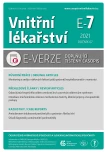-
Medical journals
- Career
Monitoring and analysis of fall risk factors in hospitalized patients
Authors: Iva Brabcová 1; Hana Hajduchová 1; Valérie Tóthová 1; Sylva Bártlová 1; Jiří Holý 1; Martin Doseděl 2; Josef Malý 2; Jiří Vlček 2
Authors‘ workplace: Zdravotně sociální fakulta Jihočeské univerzity v Českých Budějovicích, Ústav ošetřovatelství, porodní asistence a neodkladné péče, České Budějovice 1; Farmaceutická fakulta v Hradci Králové, Univerzita Karlova, Katedra sociální a klinické farmacie, Hradec Králové 2
Published in: Vnitř Lék 2021; 67(E-7): 3-7
Category: Original Contributions
Overview
Goal: The goal of the study was to identify pharmacological and non-pharmacological fall risk factors in hospitalized patients. Methodology: A multicenter observational case study and monitoring was chosen for this purpose. The study involved patients hospitalized at 20 hospital units of the South Bohemian Region between 2017 and 2019. The total number included 378 patients with falls (case group) and 1,821 patients without falls (control group).
Results: Dementia OR 2.47 [95%; CI 2.01–3.76] and stroke OR 6.83 [95%; CI: 3.47–13.45] were the most probable diagnoses to increase the fall risk. The medication groups that significantly increased the fall risk included psycholeptics, antipsychotics, particularly tiaprid, and ophthalmology drugs. The significant non-pharmacological risk factors included the presence of falls in the case history, an increased fall risk at the admission, patient`s reduced mobility, confusion and restlessness. On the other hand, an early physiotherapy was identified as a protective factor reducing the fall risk.
Conclusion: The study shows that causes of falls have a multifactorial character. The plan for the prevention of hospitalized patients` falls needs to be complex and, at the same time, highly individualized. This can be achieved by multidisciplinary cooperation of the healthcare team. Besides doctors, nurses and physiotherapists, clinical pharmacists start to play an important role.
Keywords:
nurse – Patients – Falls – pharmacist – risk factors – hospital – doctor
Sources
1. Abreu C, Mendes A, Monteiro J et al. Falls in hospital settings: a longitudinal study. Rev. Latino‑Am. Enfermagem 2012; 20(3): 597–603.
2. Russell M, Clapperton A, Vu T et al. Trends in fall‑related hospitalisations in older people living in aged care facilities. Osteoporosis Int 2014; 26(3): 1219–1224.
3. Kosse N, de Groot MH, Vuillerme N et al. Factors related to the high fall rate in long‑term care residents with dementia. International Psychogeriatrics, 2015; 27(5): 803–814.
4. Singh I, Edwards C, Okeke J. Impact of cognitive impairment on inpatient falls in single room setting and its adverse outcomes, Gerontol Geriatr Res 2015; S4–001.
5. Abraham S. Factors Contributing to Psychiatric Patient Falls. J Community Med Health Educ 2016; 6(2).
6. The Joint Commission. Sentinel Event Alert 55: preventing falls and fall‑related injuries in health care facilities 2015. JCI. [cit. 2019-01-17]. Dostupné z WWW: <www.jointcommission.org/sea_issue_55/>.
7. Luzia MF, Cassola TP, Suzuki LM et al. Incidence of falls and preventive actions in a University Hospital. Rev Esc Enferm USP 2018; 52(0): e03308. Dostupné z DOI: <http://dx.doi.org/10.1590/S1980-220X2017024203308>.
8. Johnston M, Magnan MA. Using a Fall Prevention Checklist to Reduce Hospital Falls: Results of a Quality Improvement Project. AJN 2019; 119(3): 43–49.
9. Beauchet O, Dubost V, Revel‑Delhom C et al. How to manage recurrent falls in clinical practice: Guidelines of the French society of geriatrics and gerontology. The Journal of Nutrition, Health & Aging 2011; 15(1): 79–84.
10. Muir SW, Gopaul K, Montero Odasso MM. The role of cognitive impairment in fall risk among older adults: a systematic review and meta‑analysis. Age and Ageing 2012; 41(3): 299–308.
11. Zhang W, Low LF, Schwenk M et al. Review of Gait, Cognition, and Fall Risks with Implications for Fall Prevention in Older Adults with Dementia. Dement Geriatr Cogn Disord 2019; 1–13.
12. Allan LM, Ballard CG, Rowan EN et al. Incidence and Prediction of Falls in Dementia: A Prospective Study in Older People. PLoS ONE 2009; 4(5): e5521.
13. Inouye SK, Westendorp RGJ, Sacynski JS. Delirium in elderly people. Lancet 2014; 383(9920): 911–922. Dostupné z DOI: <https://doi.org/10.1016/S0140-6736(13)60688-1>.
14. Nanda S, Dey T, Gulstrand RE Jr et al. Fall risk assesment in geriatric‑psychiatric inpatients to lower events (FRAGILE). J Gerontol Nurs 2011; 37 : 22–30.
15. Tan K, Tan M. Stroke and Falls–Clash of the Two Titans in Geriatrics. Geriatrics 2016; 1(4): 31.
16. SÚKL (Státní ústav pro kontrolu léčiv). Databáze léků. [02-02-2020]. Dostupné z WWW: <http://www.sukl.cz/modules/medication/search.php>.
17. Quigley PA, Bulat T, Hart–Hughes S. Strategies to Reduce Risk of Fall–Related Injuries in Rehabilitation Nursing. Rehabilitation Nursing 2007; 32(3): e120–1e25. Dostupné z DOI: <https://doi.org/10.1002/j.2048-7940.2007.tb00163.x>.
18. Sherrington C, Tiedemann A. Physiotherapy in the prevention of falls in older people. Journal of Physiotherapy 2015; 61(2): 54–60.
19. Cameron ID, Gillespie LD, Robertson MC et al. Interventions for preventing falls in older people in care facilities and hospitals. Cochrane Database of Systematic Reviews 2012; 12 : 181 s.
20. Sheehan KJ, O’Connell MD, Cunningham C et al. The relationship between increased body mass index and frailty on falls in community dwelling older adults. BMC Geriatrics 2013; 13(1).
Labels
Diabetology Endocrinology Internal medicine
Article was published inInternal Medicine

2021 Issue E-7-
All articles in this issue
- Monitoring and analysis of fall risk factors in hospitalized patients
- Recommendations for safe collection of venous blood by a closed collection system
- Amanita phalloides intoxication: mechanism of toxicity, clinical manifestations and therapeutic approaches
- Amiodarone induced pulmonary toxicity
- Pitfalls of diagnosing autoimmune pancreatitis
- Internal Medicine
- Journal archive
- Current issue
- Online only
- About the journal
Most read in this issue- Amanita phalloides intoxication: mechanism of toxicity, clinical manifestations and therapeutic approaches
- Amiodarone induced pulmonary toxicity
- Recommendations for safe collection of venous blood by a closed collection system
- Pitfalls of diagnosing autoimmune pancreatitis
Login#ADS_BOTTOM_SCRIPTS#Forgotten passwordEnter the email address that you registered with. We will send you instructions on how to set a new password.
- Career

